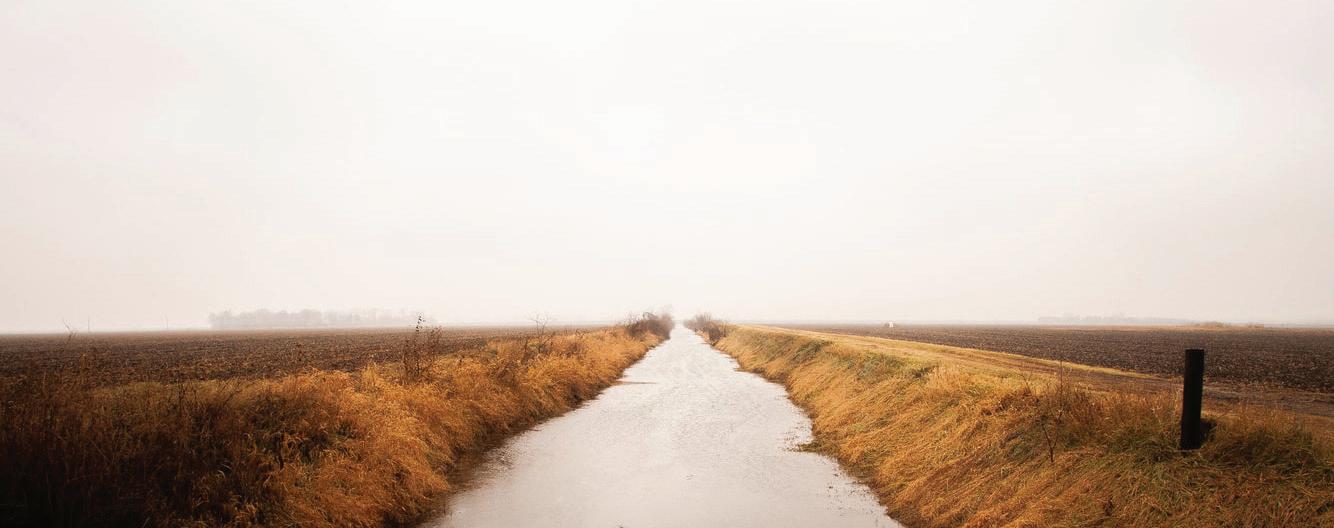
11 minute read
Updates & Stories
on thecutting edge of field practices Sara Carmichael Treating tile outlets through a variety of edge of field practices can intercept nitrogen-rich water before it gets to the stream, creek, or river. These practices also play a crucial role in meeting the Iowa Nutrient Reduction Strategy of 45% reduction in total nitrogen and phosphorus loads leaving Iowa land. But what are edge of field practices, exactly? We’re talking about wetlands, riparian buffers, oxbows, terraces, drainage water management systems, and in the case of a new program we’re rolling out, bioreactors and saturated buffers.
Both bioreactors and saturated buffers require minimal maintenance, have no impact to cropland, and show good lifespan with the bioreactor lasting up to 15 years and the saturated buffer lasting as long as the practice is in place.
Advertisement
But, these practices have not been widely installed in Iowa due to a variety of factors including paperwork and financial burden to the landowner. In the past ten years, the state has been able to install only 100 of these edge of field practices. That all changed last year when Polk County figured out a way to scale up and installed 51 in one year. Year two they are planning on installing over 100, with some in Story County! With the help of federal, state, and private partners, Polk County took on the surveying, engineering, and financial burden for all landowners. Now, Story County, City of Ames, and other partners are joining this endeavor. In 2022 we hope to install at least 25 of these practices throughout Keigley Branch, East Indian Creek, and Bear Creek watersheds. Furthermore, all practices will be 100% covered for the landowners through a cost share PLUS will earn a $1,000 easement payment per tile outlet treated.
For more information about this program and to see if your land is suitable for these practices, please contact Sara Carmichael, Watershed Coordinator at scarmichael@storycountyiowa.gov or 515-598-1652.
Bioreactors are large underground trenches filled with woodchips. Tile-drained water is diverted to this area where microorganisms use the woodchips as a carbon source to covert nitrate in the water to nitrogen gas. The water is then allowed to drain into the nearby waterway. Bioreactors can drain anywhere from 30-100 acres with average nitrate removal of 43%. Saturated buffers are vegetated areas along a stream that remove nitrates from tile-drained water. This practice directs a portion of the tile-drained water into the buffer rather than discharging directly into a waterway. Saturated buffers have an average nitrate removal of 50%, but have been shown to remove up to 92% on an annual basis.
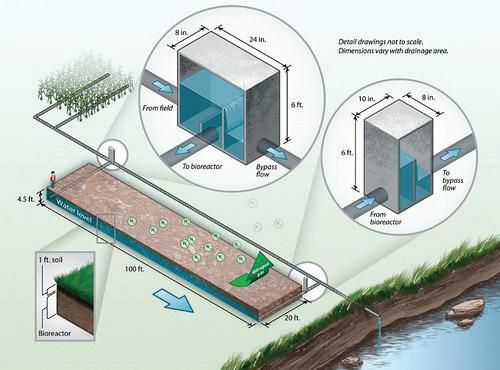
Image by John Peterson
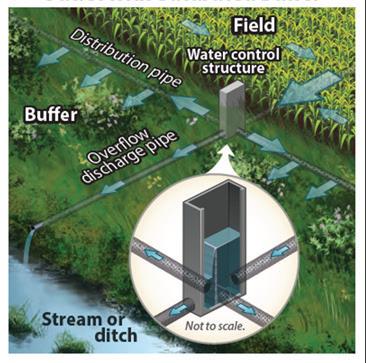
Both graphics from the USDA
Established just last year, the Natural Resource Steward volunteer position has already proven itself to be hugely valuable, allowing us to better allocate resources to accomplish many natural resource projects at once. In this new model of invasive species managment, volunteers are empowered through more training and responsibility. They become licensed as commercial pesticide applicators, a necessary requirement in order to apply herbicide on public lands. Two individuals came forward right away when we announced the new volunteer NaturalResource Stewards opportunity and got their licenses in a hurry! Rick Dietz has been focusing on undesired shrubs (mostly honeysuckle) near McFarland Lake and at the Deppe Property, adjacent to McFarland Park, that will soon become a public area. Removing these dense shrubs near the water allows native grasses and forbs to grow, better stabilizing the soil and improving water quality. Bob Hartlzer has been tackling honeysuckle and oriental bittersweet in the oak/hickory savanna restoration at Christiansen Forest Preserve. This work is allowing sunlight to hit the forest floor that will help stimulate the native vegetation. We owe a big thank you to Rick and Bob for all their efforts this past year. If just two folks can get THIS much work done, we are extremely excited for what the future of this program holds.
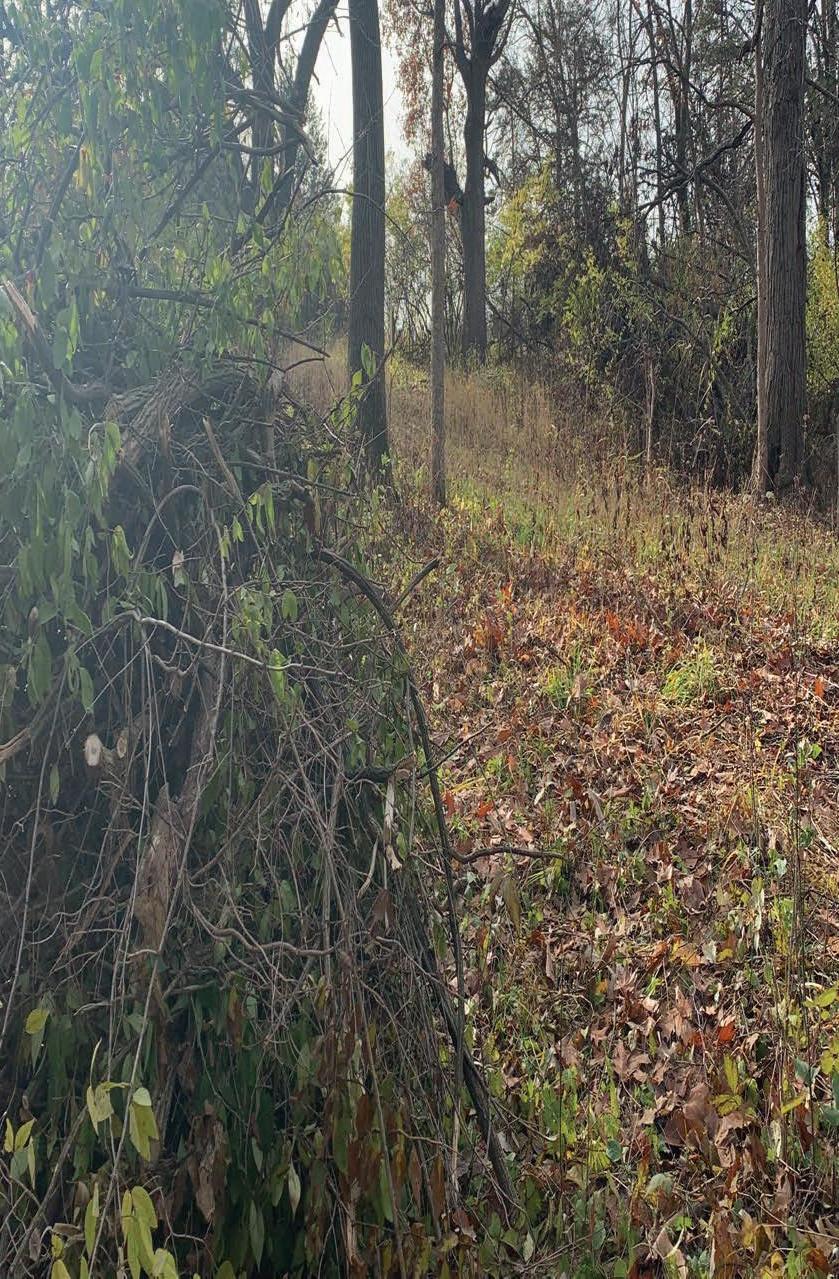
Are you interested in helping us restore native ecosystems, wildlife habitat, and water quality by obtaining this license? If so, visit the “Get Involved” tab on our website! Volunteers will be assigned a project in one of the parks and trained to remove undesired and invasive plants.
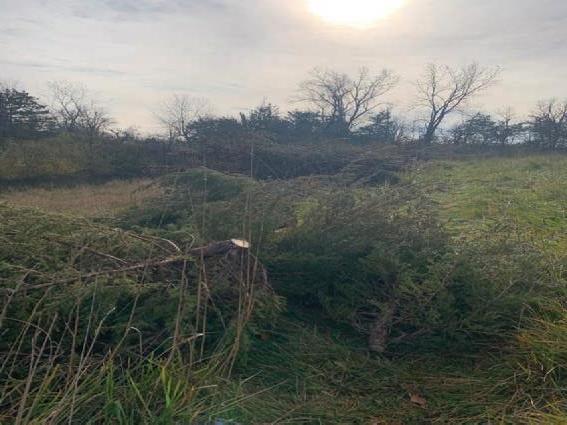
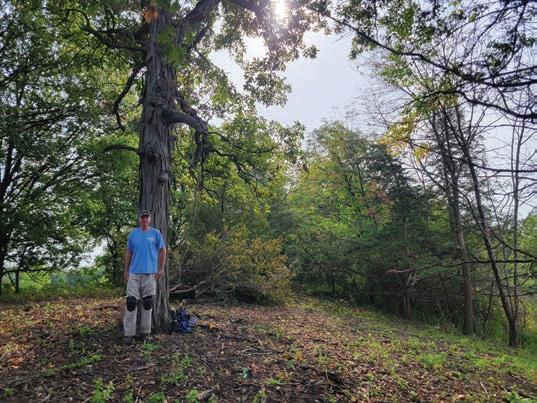

“I had hoped to get into conservation work when I started college, but was diverted by job availability. This position provides the opportunity to do the type of activity I had initially hoped to do.” ~ Bob Hartzler
“It's satisfying to see an instant change when invasives (especially honeysuckle) are removed from a woodland or prairie.” ~Rick Dietz

Welcome new naturalist, Bobbi Donovan


Coaches Special Olympics sports

Has been Has been skydiving skydiving twice
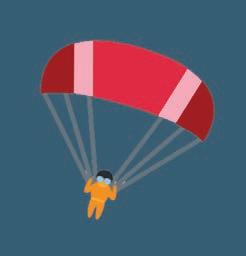

Has a Masters in Has a Masters in Natural Resource Natural Resource Science and Management Management
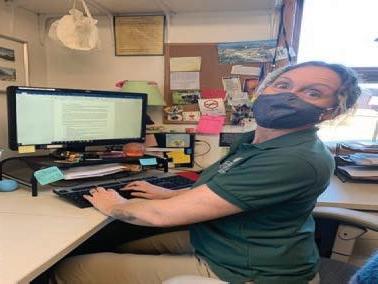

Studied abroad in Australia

...Wha� d�e� � na��r��is� d�?
Beth Waage
Random questions and comments throughout my career have led me to believe that many people don’t know what a naturliast does when they aren’t teaching a program! Let me give a behindthe-scenes view of what goes on when we’re not in the public eye.
The programs we teach, whether to a class, community group, or the general public, don’t just happen. They take preparation: making sure we have the materials, information, and plan. Sometimes all we need is some talking points and a trail while other programs require extensive outlines and a long list of materials. Especially in the case of bigger events like nature camps, a scouting trip might be necessary to first identify and clear any hazards or plan a route through the park. Sometimes just locating a prop for a program becomes a time intensive task. You can’t simple find a woman’s pioneer dress from 1869 on Amazon! Luckily, we have wonderful community members who are able to help us with some of our more unusual requests.
Preparing for and presenting programs is the bulk of our work. However, some other things we spend our time on include:
• Writing for a variety of things like grant applications, articles, or interpretive panels in the parks • Caring for our education animals • Water testing in Story County streams • Attending or presenting at conferences and other professional development opportunities • Serving on committees or boards for professional organizations like Iowa
Association of Naturalists or the National Association of
Interpretation • Redoing displays in the conservation Center
There are probably a few things I am missing. I became a naturalist because I enjoy interacting with people and teaching them about the outdoors, but those special moments take time to plan.

Photo by Linda Wendt
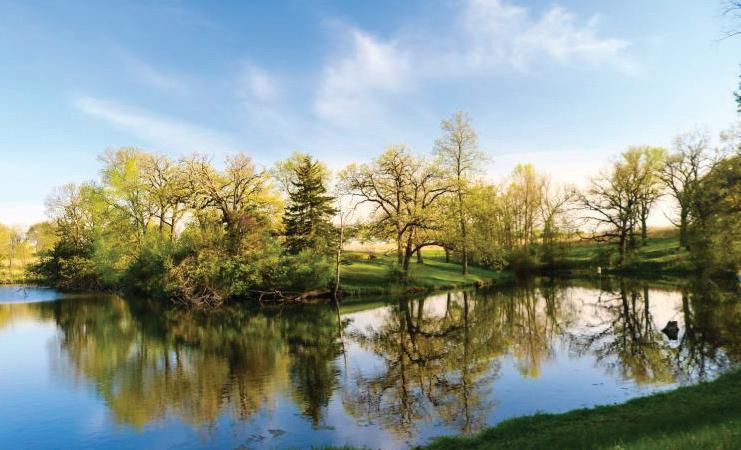
Did you know the average impounded lake in Iowa has a “healthy” lifespan of about 30 years? McFarland Lake, visible from the Story County Conservation Center, was originally created in 1947 and came to its current size and shape in 1969. Quick math tells you that this lake is over 50 years old and 20 years past that average “healthy” age referenced above. So, what qualifies a lake as healthy?
Lake health includes a range of biological, physical, and aesthetic functions. Aquatic species diversity and health, nutrient and sediment loading, and other components of water quality all interact in the delicate balance of a lake’s composition. How users value and interact with the water body also help create goals in relation to lake health. Citizens come to McFarland Lake for fishing, paddling, and wildlife viewing, all of which are directly tied to water quality. How was McFarland Lake’s health declining?
After a considerable amount of data collection by ISU’s water quality working group, it was found that McFarland Lake had issues with seasonal algal blooms, low water transparency, reduced lake volume due to sedimentation, and invasive carp and snails. None of these are abnormal for an impounded lake in an agriculturally-dominated landscape. They are problems for the plants and animals calling the lake home and for recreation opportunities. And the problems are all connected. Sediment travels into the lake from soil runoff and erosion, carrying phosphorous with it. The phosphorous provides food for an algal bloom. Sediment and algae both reduce transparency, meaning less sunlight reaches the bottom, which impedes beneficial aquatic plant growth. This can reduce oxygen in the water, which not only is negative for aquatic life, but can further contribute to algal blooms. Carp stir up sediment as they feed on the bottom of the lake, literally muddying the water, which again contributes to a lack of plant growth and low transparency. Lack of beneficial aquatic vegetation means less habitat for fish we do want. Much of the barren lake bottom is also covered with invasive apple snails, which actually help filter nutrients in the water, but can be detrimental to plant growth. Fluctuating external factors such as temperature and rainfall also contribute to the aquatic ecosystem’s standing. With all these intertwining pieces, it’s easy to see how the delicate balance can get thrown off.
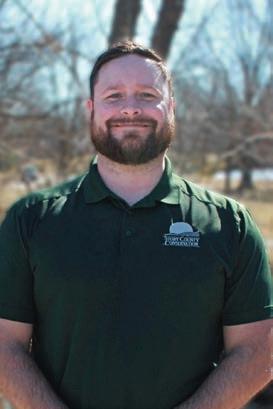
SCC and ISU’s water quality working group have analyzed the lake and collected data during an extensive study referenced as the McFarland Lake Water Quality Assessment. This data-driven document tells us what is going on in the lake from a biological perspective. We then completed a Watershed Management Plan, which identifies solutions and best management practices for the lake and its watershed. The next step is packaging all this information into a design plan. SCC is currently working with a well-qualified engineering firm to create design documents that will be used for a contractor to complete a lake restoration.

Expect more updates in the near future after design plans are finalized and funding is secured. Sediment removal, shoreline stabilization, recreational access, improved lake depth, lake drawdown capabilities, and improved lake habitat are some of our goals for the project. We want to make McFarland Lake a healthy and enjoyable destination for another 50+ years! Ryan Wiemold Parks Superintendent

Last year, a little over 7,100 Iowa taxpayers helped boost wildlife conservation with donations to the Fish and Wildlife Fund on their state tax form. The number of people donating has continually declined and represents about 0.5 percent of total taxpayers in Iowa.
However, even with that decline the amount of the donations increased by almost $25,000. This represents the biggest increase in donations in the last 20 years!
“We are thankful for those who donated to wildlife conservation with their tax refunds as the funds go directly to habitat development and restoration programs for some of Iowa’s most vulnerable animal species,” said Stephanie Shepherd, wildlife biologist with the Iowa Department of Natural Resources (DNR) Wildlife Diversity program. The Fish and Wildlife Fund, commonly known as the “Chickadee Check-off,” is a mechanism the Iowa Legislature created in the 1980s for Iowans to donate to wildlife conservation on the Iowa state income tax form. Before this time, so-called “non-game” wildlife had no dedicated funding.
Non-game wildlife are the 1,000plus species such as songbirds, bald eagles, salamanders, turtles, monarchs and bees and more that make up the majority of wildlife in Iowa. The Chickadee Check-off is one of the only funding sources for the Iowa DNR’s Wildlife Diversity program, which is responsible for these species.
Funding helps to improve wildlife habitat, restore native wildlife, provide opportunities for citizens to learn about Iowa’s natural resources, and much more. Recent projects have been investigating the nesting success of barn owls and figuring out the status of the endangered rustypatched bumblebee.
“The tax check-off line is pretty inconspicuous and can be easily missed. Be sure to remind your tax preparer that they have a client who wants to donate,” said Shepherd.
Once located, donating is easy: simply write the amount to donate next to the Fish and Wildlife CheckOff, line 57 on Form 1040, and the sum is either automatically deducted from the refund or added to the amount owed.
“If every Iowa taxpayer donated just $1, it would mean $1.5 million for wildlife and natural resource conservation,” Shepherd said.




